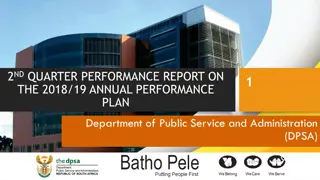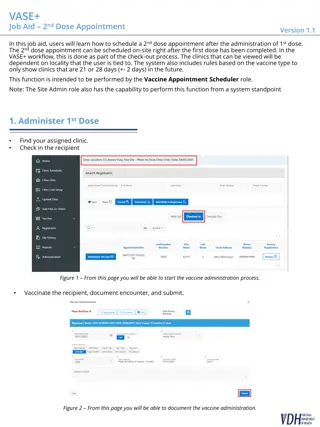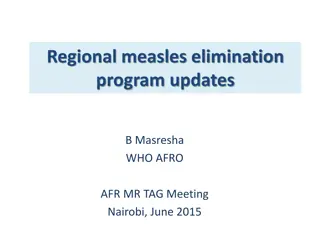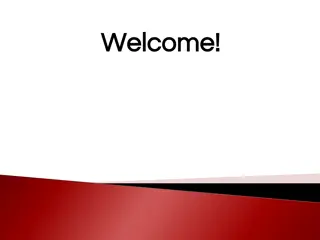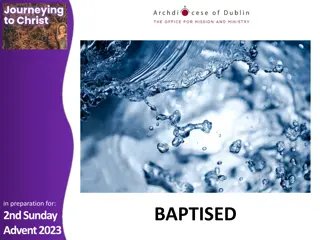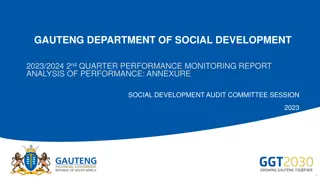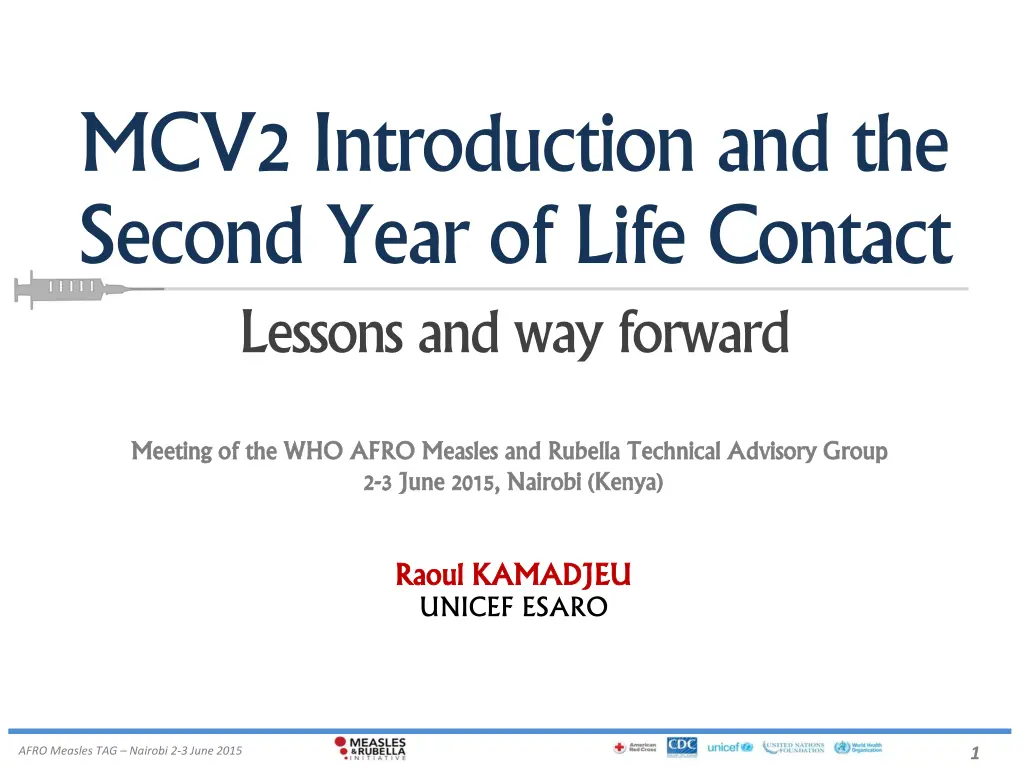
Introduction to MCV2 and Measles Immunization Strategies
Learn about the introduction of MCV2 into the EPI, challenges faced, performance evaluation, and strategies to improve coverage. Explore the WHO AFRO Measles and Rubella Technical Advisory Group meeting details in Nairobi. Discover the goals for measles and rubella elimination in the WHO regions and recommendations for MCV2 introduction.
Download Presentation

Please find below an Image/Link to download the presentation.
The content on the website is provided AS IS for your information and personal use only. It may not be sold, licensed, or shared on other websites without obtaining consent from the author. If you encounter any issues during the download, it is possible that the publisher has removed the file from their server.
You are allowed to download the files provided on this website for personal or commercial use, subject to the condition that they are used lawfully. All files are the property of their respective owners.
The content on the website is provided AS IS for your information and personal use only. It may not be sold, licensed, or shared on other websites without obtaining consent from the author.
E N D
Presentation Transcript
MCV2 Introduction and the Second Year of Life Contact Lessons and way forward Meeting of Meeting of the WHO AFRO Measles and Rubella Technical Advisory Group the WHO AFRO Measles and Rubella Technical Advisory Group 2 2- -3 June 2015, Nairobi (Kenya) 3 June 2015, Nairobi (Kenya) Raoul KAMADJEU Raoul KAMADJEU UNICEF ESARO 1 AFRO Measles TAG Nairobi 2-3 June 2015
Outline 1. Background on MCV2 2. MCV2 introduction into EPI - Status update 3. MCV2 performance 4. Challenges o MCV2 introduction: findings of MCV2 PIEs 5. Improving MCV2 coverage and way forward 6. Conclusion and questions to the TAG 2 AFRO Measles TAG Nairobi 2-3 June 2015
MCV2 - Background 3 AFRO Measles TAG Nairobi 2-3 June 2015
Measles and Rubella Elimination Goals by WHO Region 2015 2015 2000 2010 2015 2012 2020 2020 4 AFRO Measles TAG Nairobi 2-3 June 2015
The introduction of a second dose of measles immunization in RI in eligible countries a major strategic approach to maintain high quality population immunity* *Measles Elimination By 2020: A Strategy For The African Region - AFR/RC61/8 16 June 2011 (WHO AFRO) 5 AFRO Measles TAG Nairobi 2-3 June 2015
AFRO Measles TAG position on MCV2* TAG suggested criteria for MCV2 introduction: Achievement of MCV1 coverage >80%, maintained for at least three consecutive years using WHO/UNICEF best estimates of vaccine coverage; and Attainment of one of the two primary measles surveillance performance indicators for at least two consecutive years. *Report of the Second Meeting of the African Regional Measles Technical Advisory Group (TAG) Recommendations (2008) 6 AFRO Measles TAG Nairobi 2-3 June 2015
WHO recommendation on MCV2 * All children should receive two doses of measles vaccine Minimum interval of one month between doses MCV1 at 9 or 12 months When MCV1 > 80% for 3 years then add MCV2 at: 15-18 months (if country has ongoing measles transmission) school entry (option if near elimination) Very high coverage (>90%) needed with both doses Mortality reduction: >90% national, >80% in every district Elimination: >95% in every district School entry screening for vaccination status *WHO Measles Vaccine Position Paper, WER Aug 2009 (http://www.who.int/wer/2009/wer8435.pdf) 7 AFRO Measles TAG Nairobi 2-3 June 2015
MCV2 introduction into EPI AFRO Status update 8 AFRO Measles TAG Nairobi 2-3 June 2015
AFRO countries MCV2 status* MCV2 as of May 2015: 19 countries (40%) MCV2 planned by end 2015: 5 (10%) By the end of 2015, 24 countries (51% of AFRO countries) would have introduced MCV2 into their RI schedule Introduced to date (19 Countries) Planned introductions by end 2015 (5 Countries) No introduction planned by 2015 (27) Not applicable (Not AFRO) *As of May 205 9 AFRO Measles TAG Nairobi 2-3 June 2015
MCV2 introduction MCV1 pre-introduction All the countries introducing MCV2 have fulfilled the criteria of national MCV1 coverage 80% for 3 consecutive years and have sustained high MCV1 in the years preceding MCV2 introduction. MCV2 year of introduction MCV1 coverage 3 years pre-introduction Country 2014 2013 2012 2011 2010 2009 2008 2007 2006 Botswana 94 94 94 94 94 94 94 94 Burkina Faso 82 87 89 92 94 94 94 88 Burundi 98 93 93 92 91 84 88 92 Capo Verde 91 91 96 97 97 96 95 94 Eritrea 96 98 99 99 99 97 97 95 Gambia 96 95 91 92 96 92 88 89 Kenya 93 93 87 86 88 90 80 77 Rwanda 97 97 97 95 Ghana 88 91 93 93 86 95 85 91 Sao Tome 92 91 92 Senegal 84 83 84 81 79 77 84 80 Tanzania 99 97 93 92 91 88 90 93 Zambia 80 82 83 96 90 87 93 85 Data source: Official country reported coverage estimates Access in May 2015 10 AFRO Measles TAG Nairobi 2-3 June 2015
MCV2 introduction status update Year of introduction Vaccine for MCV2 visit Support for introduction Countries Age of administration PIE (Year) 6 years (18 months from 2015) with MMR1 at 11 months 18 months 6 yrs (MCV1 at 15 months) 12-15-18 months 18 months 18 months 18 months 18 months 18 months 18 months 18 months 18 months 18 months 18 months 18 months 18 months 12 months 15 months 18 months Algeria Lesotho Seychelles South Africa Swaziland Mauritius Capo Verde Eritrea Gambia 10 Ghana 11 Botswana 12 Burundi 13 Kenya 14 Sao Tome 15 Zambia 16 Burkina Faso 17 Rwanda 18 Senegal 19 Tanzania 1 2 3 4 5 6 7 8 9 2000 2000 2000 2000 2002 2003 2009 2012 2012 2012 2013 2013 2013 2013 2013 2014 2014 2014 2014 M (MMR from 2015) M MMR M/MMR M M MMR M M M M M M MR M M M MR MR SELF SELF SELF SELF SELF SELF SELF +GAVI +GAVI +GAVI +GAVI +GAVI SELF +GAVI +GAVI +GAVI +GAVI +GAVI +GAVI 2015 2013 2014 2015 2014 10 out of the 19 countries (52%) have introduced MVC2 with GAVI support. A PIE was conducted in 5 countries with MCV2 introduction date > 2012 MCV2 is in most cases provided at 18 months of age. Few exceptions to this rules are Senegal and Seychelles. Three countries are providing MR as MCV2 while 4 countries are providing MMR 11 AFRO Measles TAG Nairobi 2-3 June 2015
MCV2 performance 12 AFRO Measles TAG Nairobi 2-3 June 2015
MCV2 performance MCV2 60 - 80% No data MCV2 < 60% MCV2 > 80% Country Algeria Lesotho Seychelles South Africa Swaziland Mauritius Capo Verde Eritrea Gambia 10 Ghana 11 Botswana 12 Burundi 13 Kenya 14 Sao Tome 15 Burkina Faso 16 Rwanda 17 Senegal 18 Tanzania 19 Zambia Year of MCV2 introduction 2000 2000 2000 2000 2002 2003 2009 2012 2012 2012 2013 2013 2013 2013 2014 2014 2014 2014 2014 MCV2 2014 100 54 98 81 89 85 79 69** 73 67 85 60 25** 71 1 2 3 4 5 6 7 8 9 77 13 44 33 MCV2 coverage < 80%: 12 including 5 with MCV2<60% *Data source: Official country reported coverage estimates Access in May 2015 ** Not yet officially reported by the country 13 AFRO Measles TAG Nairobi 2-3 June 2015
MCV2 performance in early introduction* MCV2 coverage at Year 1, Year 2 and Year 3 post introduction 100 90 80% 80 70 60 50 40 30 20 10 0 ALG BWA BFA BDI CPV ERI GAM GHA KEN LSO MUS SEN SYC SWZ ZAF TZN ZMB RWA Year 3 Year 2 Year 1 *Data source: Official country reported coverage estimates Access in May 2015 14 AFRO Measles TAG Nairobi 2-3 June 2015
MCV1 - MCV2 dropout rate 2014* 20% SEN (2014) KEN (2013) ZMB (2013) TZA (2014) BDI (2013) GHA (2012) GMB (2012) ERI (2012) STP (2013) RWA (2014) CPV (2009) MUS (2003) ZAF (2000) SWZ (2002) LSO (2000) BWA (2013) SYC (2000) DZA (2000) -10% 0% 10% 20% 30% 40% 50% 60% 70% 80% 90% Drop out rate (%) *Data source: WHO/UNICEF reported National Immunization Coverage 2014 15 AFRO Measles TAG Nairobi 2-3 June 2015
MCV2 coverage trend in early introducers (2004 to 2013) SYC 100 DZA 90 80 MUS 70 SWZ LSO 60 50 ZAF 40 30 2004 2005 2006 2007 2008 2009 2010 2011 2012 2013 Some countries were able to achieve and maintain high coverage early in MCV2 introduction 16 AFRO Measles TAG Nairobi 2-3 June 2015
Challenges to MCV2 introduction and uptake Key summary findings of PIEs 17 AFRO Measles TAG Nairobi 2-3 June 2015
MCV2 Post Introduction Evaluations Purpose to evaluate the impact of introduction on country s immunization program To rapidly identify problems needing correction PIE to be conducted 6 12 months following the introduction (WHO Recommendation) Assessment conducted at all levels of the health system by a team of experts (national and internationals) using adapted tools 18 AFRO Measles TAG Nairobi 2-3 June 2015
PIE programmatic areas assessed Advocacy, comm, soc mob Planning and process Monitoring and supervis. Sustain. and finance Monitoring of AEFI Service delivery, recording, reporting Injection safety and waste disposal Cold chain, vaccine mgt and logistic Training and Knowledge of HCW 19 AFRO Measles TAG Nairobi 2-3 June 2015
MCV2 PIEs implementation status Year Done 2013 Ghana (MCV2, PCV, RV) (August, 19 months after introduction) 2014 Burundi (MCV2, RV) (June, 17 months after introduction) Zambia (MCV, PCV, RV combined with EPI and in-depth surveillance review) (July, 12 months after introduction) 2015 Eritrea (MCV2, RV) (Feb, 31 months after introduction) Kenya (MCV2, RV) (May, 22 months after introduction) Planned Senegal Gambia Tanzania 20 AFRO Measles TAG Nairobi 2-3 June 2015
MCV2 PIEs Key findings Programmatic areas Key findings Strategies to reach children > 9 months not planned Strategies for vaccination in second year of life not established Opportunities to link MCV2 with other child health activities >1 year not fully explored Strategies for defaulters tracing not in place Lack of clarity when zero-dose children come in for MCV2. Knowledge of HCW sub-optimal (training for MCV2 not given sufficient attention since it is an old vaccine ) Service delivery, integration, reducing missed opportunities 21 AFRO Measles TAG Nairobi 2-3 June 2015
MCV2 PIEs Key findings Programmatic areas Key findings Provision of immunization service > 1 year new to care takers Sub-optimal knowledge of EPI clients on MCV2 and immunization activities > 1 year Demand creation activities limited Opportunities to increase demand creation exist but are not fully harnessed (health education during EPI sessions/antenatal visits, health visits, mass media, etc..) Demand creation 22 AFRO Measles TAG Nairobi 2-3 June 2015
MCV2 PIEs Key findings Programmatic areas Key findings Unstable population figures Target population for MCV2 new to the program and not widely understood Recording of MCV doses still a challenge Monitoring of MCV2 not fully established Poor recording of MCV2 doses Monitoring of MCV2 at all levels not established High MCV1-MCV2 dropout rates observed (reflecting low MCV2 coverage) but not monitored Impact of MCV2 introduction on vaccine utilization/wastage is not systematically monitored Monitoring of doses/coverage /dropout 23 AFRO Measles TAG Nairobi 2-3 June 2015
Improving MCV2 coverage Way forward 24 AFRO Measles TAG Nairobi 2-3 June 2015
Modeling MCV2 impact Theoretical model 1,400 Thousands 1,300 No MCV2 MCV1 = 80% Assumed constant over years 1,200 1,100 1,000 900 MCV2 = 40% 800 MCV2 = 50% 700 600 MCV2 = 60% Birth cohort 500 MCV2 = 70% 400 MCV2 = 80% 300 MCV SIAs MCV2 = 90% 200 100 0 Y1 Y2 Y3 Y4 Y5 Y6 Y7 Y8 Susceptible accumulated above birth cohort Recommended time for measles SIA Changes in susceptible population by level of MCV2 coverage in a theoretical population with a birth cohort of 500,000, assuming MCV1 coverage 80% at 9 months maintained over time. At coverage 70%, 80% and 90% it will take 9, 13 and 22 years respectively for the population of susceptible to accumulate above the birth cohort 25 AFRO Measles TAG Nairobi 2-3 June 2015
Way forward to improve MCV2 performance 1. Institution of a pre-MCV2 introduction readiness assessment/planning tool developed by WHO/UNICEF? 2. WHO-AFRO to institute reporting on dropout between MCV1 and MCV2 as key performance indicator (to be reported in feedback bulletin and included in monitoring charts ) for countries with MCV2 3. WHO and UNICEF to conduct additional operational research on strategies/best practices to improve MCV2 coverage around: service delivery, demand creation and integration with 2nd year of life activities 26 AFRO Measles TAG Nairobi 2-3 June 2015
Way forward to improve MCV2 performance 4. Sharing lessons learned and best practice from other countries to inform MCV2 introduction and performance 5. Changing EPI target age from the historic 9 months (0- 11 months) to under 2 or under 5 years 6. Monitoring the implementation of PIEs recommendations 27 AFRO Measles TAG Nairobi 2-3 June 2015
Conclusion and questions to the TAG 28 AFRO Measles TAG Nairobi 2-3 June 2015
Conclusion 19 countries in WHO/AFRO Region (40%) have introduced MCV2 into their RI schedule, with more countries planning to introduce MCV2 in the near future Concerns remain over low performance of MCV2 and appropriate actions should be taken to improve MCV2 performance Not all countries have exploited MCV2 introduction to make policy and practice changes to increase MCV1 and MCV2 coverage 29 AFRO Measles TAG Nairobi 2-3 June 2015
Questions to the TAG on MCV2 1. Is it time the TAG revisit its MCV2 introduction criteria that were set in 2008 (coverage criteria, surveillance criteria)? 2. Should WHO institutes a pre-introduction assessment (6, 8 months prior to MCV2 introduction?) 3. Should AFRO countries institute universal school entry MCV checks and referral when there is not evidence of 2 doses of MCV? 30 AFRO Measles TAG Nairobi 2-3 June 2015
Thank you 31 AFRO Measles TAG Nairobi 2-3 June 2015





